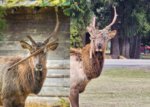
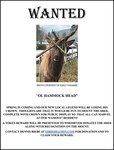
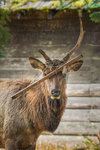
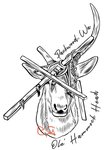
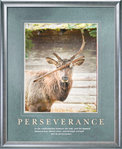
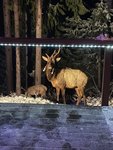
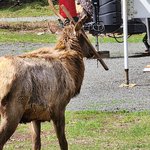
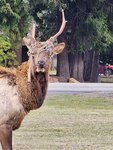
He’s a household name. He wears a crown. No palace holds him, yet he’s fond of bucking ham…mocks.
Hammock Head, or sometimes Ole’ Hammock Head, is an elk. Lewis County’s easternmost community, the low mountain town of Packwood, is stocked full of them. Using aerial surveys, the Puyallup Tribe estimated the South Rainier herd, of which Packwood’s elk are members, had 1,193 total elk in 2022. The Upper Cowlitz River Valley area sub-herds haven’t been counted in recent years, but residents estimate the population is in the low hundreds.
Among them, Hammock Head has become local royalty.
“Last September, he’d obviously had a tussle with somebody’s hammock and the hammock lost,” said Dennis Riebe, who has had a cabin in Packwood’s High Valley neighborhood since the 1980s.
In late summer and early fall, bull elk battle one another for females, also called cows. They’ll vigorously rub their antlers on trees and shrubs to shed the velvet of their new antlers. Hammock Head was likely in this process when he destroyed someone’s hammock — and took some pieces with him.
Months later, the elk still wears a chain and wood over his antlers and, now, the hunt for his spring shed is on. When the elk drops his antlers, hammock parts and all, locals are hoping to collect the leftovers and immortalize the crown in a museum.
To drum up excitement over the shed, Riebe distributed “wanted” posters around town.
“As I understand it from one of our other residents who knows all about elk, he’s about a 2-year-old elk. This is maybe his first or second set of antlers,” Riebe said. “So folks are starting to speculate now that (the shed) should be within the next two weeks.”
While the elk was already recognizable from his accessory, Riebe’s efforts were the first in a snowball of Hammock Head’s fame. By the second day distributing the posters, several shops he entered already had theirs.
In the following weeks, the poster would be hung in Morton’s grocery store, over 30 miles away. There, the East County Journal, a weekly publication, put news of the hunt for Hammock Head’s shed on the front page. When he does shed, Riebe said he’ll remain recognizable by the bald spots the wood has caused.
In what he called the “doldrums of winter,” Riebe said he saw the phenomena as a way to cheer Packwood up.
“We could use a little bit of excitement,” he said. “So all our local tourist friends can see and enjoy the allure of Hammock Head. … And then things started to take off, like, ‘Oh he was in my yard yesterday,’ or, ‘He was down at the firehouse last night.’”
Just this week, the celebrity elk made it on to shirts and sweatshirts by artist Esther Griffith. Apparel with her rendition of him is available for purchase at https://bit.ly/Hammock-Head-Art and stickers are next, Griffith said.
“My plan is to sell the stickers at the historical museum in Packwood. (A) portion of the proceeds will go to the historical society of our town,” Griffith said.
Others have turned the elk into a motivational icon. With a stunning photo of the beast marked with a backdrop of rain and a woodshed taken by Heather Weagant, resident Ryan Southard created a poster of Hammock Head that reads: “PERSEVERANCE: In the confrontation between the bull and the hammock, Hammock Head always wins … Not through strength, but by perseverance.”
That post received 233 likes on Facebook, which Riebe noted, in a town with about 1,000 people, illustrates the elk’s popularity.
Riebe said many of the various endeavors using the elk’s likeness are set to donate proceeds to the White Pass Country Historical Museum, which is where he hopes to see Hammock Head’s shed.
“About a week ago, two local kids found the rest of the hammock in the woods, the balance of the hammock. Evidently, he took off racing into the woods somehow,” Riebe said. “They found that and turned that in, thinking, ‘Oh boy, here’s our contribution.’”
While others have expressed concern over the elk’s wellbeing, Riebe said the Washington Department of Fish and Wildlife checked on Hammock Head and determined he was OK. He’s been eating and drinking normally, and will soon shed the antlers.
Per one resident, the two options for Fish and Wildlife would be to euthanize, which isn’t necessary, or tranquilize, which presents risk that if the elk were hunted and eaten, a person could consume tranquilizer.
Beyond the “community spirit raising” offered by the elk, as Riebe called it, Hammock Head is a symbol of Packwood’s era. In a growing town with booming tourism, the Cascade foothill community sees increasing occasions where wildlife have become entangled, damaged property, eaten trash, and become nuisances or hazards.
“Some folks have claimed they fed him apples, but it’s important to remember that he’s a wild animal,” Riebe said.
According to Kyle Garrison, ungulate (hooved animal) specialist with Fish and Wildlife, elk and deer are more susceptible to hoof diseases when they have diets too rich in carbohydrates, so feeding wildlife is never a good idea.
Likewise, those trying to get a picture of the celebrity elk should keep a safe distance. Especially in the summer and fall, bull elk can be dangerous. Fish and Wildlife has tips for living with wildlife and avoiding entanglement on its website, which include making fences (or hammocks) highly visible with survey tape or branches. Those can be found at https://bit.ly/WDFW-Elk.